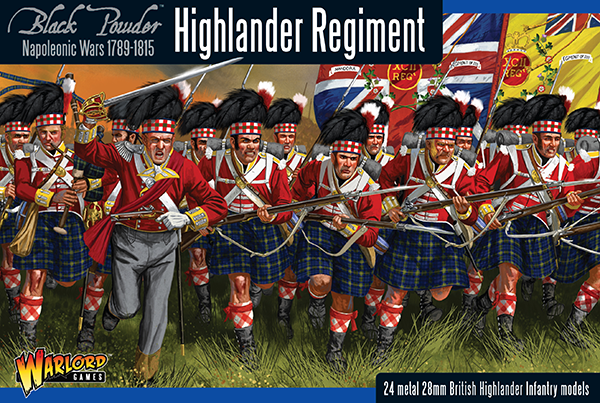W armii brytyjskiej doby napoleońskiej nie mogło zabraknąć Szkotów ubranych w kilty. Przy okazji poprzednio wykonanego oddziału poćwiczyłem malowanie szkockiej kraty - a dokładnie tartanu McKenzie. Wyszło za trzecim razem:
The British army of the Napoleonic era could not miss Scots dressed in kilts. On the occasion of the previously made unit, I practiced painting the tartan - specifically the McKenzie tartan. The third time was successful:
Przez cały okres wojen napoleońskich najsłynniejszymi oddziałami w kiltach były te z pułków numer: 42 - Black Watch, 79 - Cameron Highlanders i 91 - Gordon Highlanders. W ramach historycznej notatki zaznaczę, że duża część szkockich pułków nie zachowała kiltów do końca epoki lub nie uczestniczyła w tak wielu słynnych operacjach wojskowych, co wymienione.
W sieci najbardziej spodobał mi się następujący poradnik malowania tartanów: Painting Tartans for Toy Soldiers.
Na wstępie metodą prób, a raczej błędów odrzuciłem wykonanie 79 pułku. Uznałem schemat tego tartanu za zbyt trudny w stosunku do możliwości osiągnięcia zadowalających mnie efektów.Po eliminacjach zostały zatem 42 i 91. Jako pierwszy wykonałem 1/91 Gordon Highlanders z zestawu:
Throughout the Napoleonic Wars, the most famous units in kilts were those of Regiments number 42nd - Black Watch, 79th - Cameron Highlanders and 91st - Gordon Highlanders. As part of a historical note, I would point out that a large proportion of Scottish regiments did not keep kilts until the end of the era or did not participate in as many famous military operations as mentioned units.On the Internet, I liked the following Tartan painting guide: Painting Tartans for Toy Soldiers.
At the beginning, I rejected the painting of the 79th Regiment. I found its tartan pattern too difficult compared to achieving satisfactory results. Therefore, after eliminations, 42nd and 91st were left. First of two I make the 1/91st Gordon Highlanders from the set:
Oczywiście ręce kompanii wyborczych zostały dodane z innego odpowiedniego zestawu Victrixa.
Of course, the hands of the elite companies were added from another suitable Victrix set.
Generalnie poszczególne etapy sporządzania oddziału prezentowały się następująco:
In general, the stages of establishing a unit were as follows:
A ukończony 1/91 Gordon Highlanders wygląda tak:
And the completed 1/91st Gordon Highlanders looks like this:
Drugim oddziałem szkockim w kiltach został 1/42 Black Watch. Dla odmiany wykonałem go z figurek Warlorda, wzbogacając figurkami od Perrych (kompanie elitarne i konny oficer) oraz dwoma śmiesznymi figurkami zakupionymi z Black Hussar Miniatures http://www.triangleminiatures.com/BHM.htm
1/42nd Black Watch became the second Scottish unit in kilts. For a change, I made it from Warlord's models, enriching with models from Perry (elite companies and mounted officer) and two funny models purchased from Black Hussar Miniatures http://www.triangleminiatures.com/BHM.htm
Modele Warlorda są nieco brzydszej rzeźby niż Victrixa z plastiku. Poza tym są cięższe, przez co łamią im się bagnety w transporcie.
Widać, ze posiadają bermyce innego typu niż z Victrixa - z daszkiem. Przyznam się, że nie odnalazłem informacji w jakim okresie jakie oddziały szkockie nosiły bermyce z daszkiem, a w jakim bez niego.
Warlord's models are slightly uglier sculptures than Victrix's plastic. In addition, they are heavier, which breaks the bayonets in transport.
You can see that they have a type of feather bonnets other than from Victrix - with a visor. I admit that I did not find information at what time what Scottish troops wore feather bonnets with a visor and what time without it.
Warto zauważyć, że dudziarz posiada inny niż reszta oddziału wzór tartanu. Jest to tartan Royal Stewart, osobisty tartan panującego monarchy, zwyczajowo noszony przez większość dudziarzy w szkockich pułkach. Jednakże dudziarz pułku Gordon Highlanders zwyczajowo nosił tartan pułkowy.
It is worth noting that the piper has a different tartan pattern than the rest of the unit. This is the Royal Stewart tartan, the personal tartan of the reigning monarch, customarily worn by most pipers in Scottish regiments. However, the Gordon Highlanders piper customarily wore tartan of this regiment.






















Piękna jednostka. Robi wspaniałe wrażenie! Chętnie bym ich jakąś 12-funtówką poczęstował ale nie mam nic w tej skali :)
OdpowiedzUsuńDziękuję Mordredzie. Skala 28mm stoi przed Tobą otworem. Tylko czerpać pełną ręką. :)
OdpowiedzUsuń